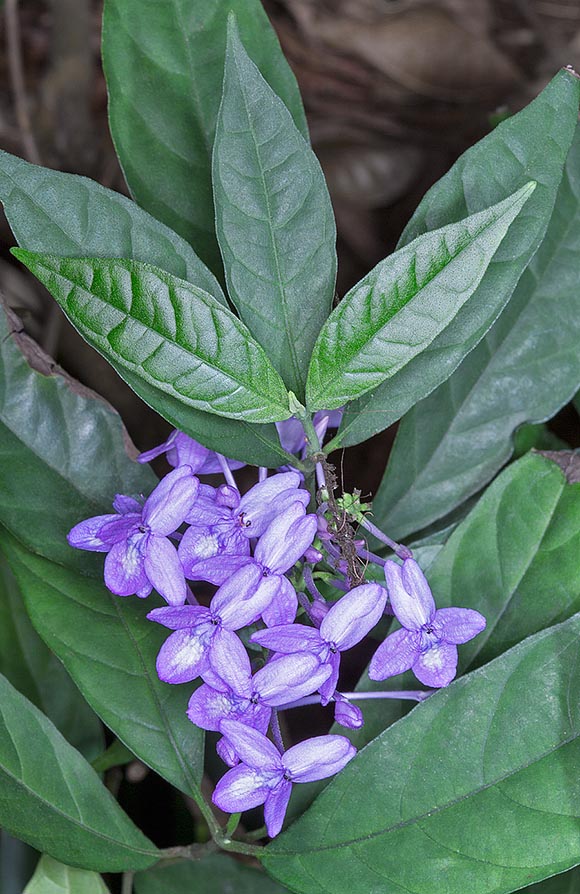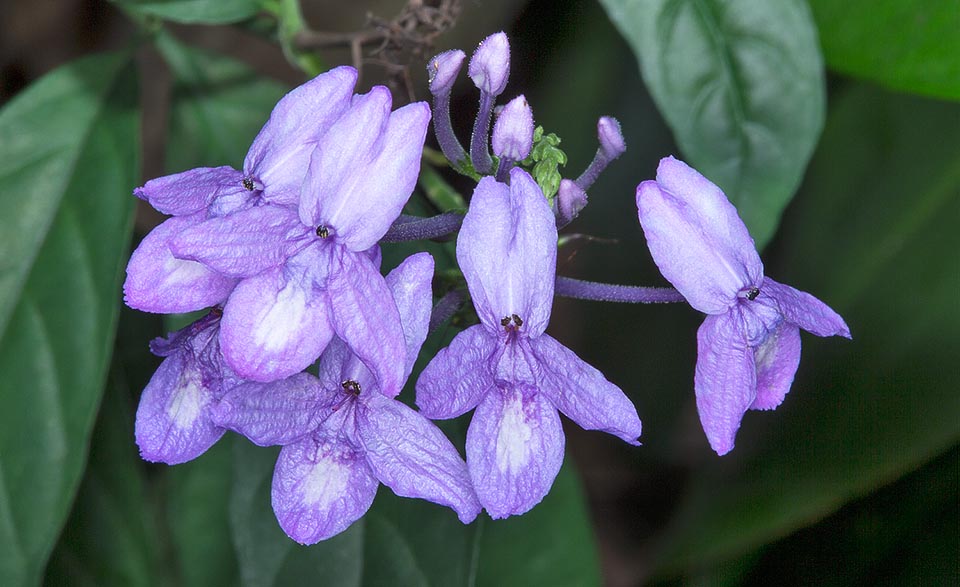Family : Acanthaceae

Text © Pietro Puccio

English translation by Mario Beltramini

The Pseuderanthemum crenulatum is a very ramified semi-shrubby tropical species © Giuseppe Mazza
The name of the genus is the combination of the Greek prefix “ψευδο-” = false and of the genus Eranthemum; the specific name is the Latin adjective “crenulatus, a, um”, from “crenula”, diminutive of “crena” = indentation, hence presenting on the margins of the leaf small rounded teeth just marked.
Common names: blue crossandra, blue twilight, Florida twilight, violet ixora (English); yun nan shan ke gu (Chinese); pokok tampang puteri (Malay); rong mei, thao lang lai (thai); xuân hoa răng (Vietnamese).
Pseuderanthemum crenulatum (Wall. ex Lindl.) Radlk. (1883) is a very ramified semi-shrubby species, that usually does not surpass the 1-1,5 m of height, with brown pubescent stems and internodes up to about 4 cm long. The leaves, on a 0,2-4 cm long petiole, are simple, opposite, elliptic-lanceolate with sharp apex, slightly crenate, bent upwards, and usually 7 prominent veins on the sides of the central one, 5-15 cm long and 3-6 cm of breadth, coriaceous, of intense green colour.
Racemose terminal inflorescences, up to 12 cm long, with a crowd of bilabiate flowers, of about 2,5 cm of diameter, pale blue to lilac with a white spot at the centre of the lower lip, that open gradually. Pubescent calyx externally, about 0,5 cm long, with 5 linear-lanceolate lobes, hypocraterimorphous corolla (with spread lobes perpendicular to a long thin tube) with 2,5-3 cm long pubescent tube, trilobate lower lip with oblong lobes, about 1 cm long, upper bilobate lip and two slightly prominent stamens. The fruit is a clavate capsule, about 2,5 cm long, containing 2-4 almost circular seeds of about 3-4 mm of diameter.
It reproduces by seed in sandy loam rich of humus, maintained humid at the temperature of 24-26 °C, and by cutting from late spring to early autumn.
Species of easy cultivation, fast growth and abundant blooming in spring-summer to be utilized as ground cover, for flowerbeds and borders in parks and gardens in the tropical and subtropical climate zones, in filtered sunlight as well as in partial shade. It requires high air humidity and perfectly draining soils, as it does not bear water stagnations, rich of organic substance, slightly acidic to slightly alkaline, maintained almost constantly humid; periodical prunings after the blooming stimulate the formation of new inflorescences.

Native to China, India, Laos, Malaysia, Thailand and Vietnam, where reaches the height of 1,5 m, is easy co cultivate, even in pot © Giuseppe Mazza
Synonyms: Pseuderanthemum malaccense (C.B. Clarke) Lindau (1904); Pseuderanthemum graciliflorum (Nees) Ridl. (1923).
